English Edition (6 MB pdf) - Saudi Aramco
English Edition (6 MB pdf) - Saudi Aramco
English Edition (6 MB pdf) - Saudi Aramco
You also want an ePaper? Increase the reach of your titles
YUMPU automatically turns print PDFs into web optimized ePapers that Google loves.
Fig. 8. Powered rotary steerable system.<br />
BIT DESIGN TOOLS<br />
To obtain the maximum potential from the PRSS, it was<br />
necessary to design a 12” PDC bit to match the system to get<br />
the proper gauge pad geometry (thickness, wrap and reinforce -<br />
ment), and to provide adequate cleaning and sufficient wellbore<br />
contact to limit over engagement and undercutting of the<br />
formation. In addition to the gauge configuration, which must<br />
match the PRSS for maximum tool steerability, the process of<br />
designing a bit to drill directionally through this tough interval<br />
provided a series of challenges that were addressed during the<br />
bit optimization process. The ultimate goal was to create a bit<br />
with the right profile and optimum cutting structure, and that<br />
provided efficient cleaning and adequate protection; it must also<br />
be steerable, stable, and durable, with a neutral walk tendency.<br />
To meet these challenges, several bit design analytical tools,<br />
including IBitS, Direction by Design (DxD), and computa -<br />
tional fluid dynamics (CFD) software, were used emphasizing<br />
bit steerability and stability.<br />
IBitS<br />
IBitS software is the bit designing tool platform that enables<br />
the bit designer to generate the cutter layout and to simulate<br />
the forces to which the bit will be exposed under specific<br />
drilling parameters. Depending on the cutter geometry and<br />
space position on the bit face, this tool can be used to<br />
calculate the torsional, axial, and lateral forces of each cutting<br />
element showing the total bit force imbalance as output. Force<br />
imbalance provides a good measure of the bit stability<br />
through homogenous intervals. The IBitS tool can also be used<br />
to calculate the bit force. It obtains low values by manipu -<br />
lating the cutter layout and enables increased bit energy levels<br />
by evenly distributing cutter forces. It also includes the<br />
transition drilling model, which helps to identify possible<br />
areas of impact damage when the bit moves from soft to more<br />
competent formations.<br />
Direction by Design<br />
Direction by Design software is a high-technology analytical<br />
tool that provides advanced bit design engineering to optimize<br />
directional performance. It provides a powerful means of<br />
optimizing the matched bit design for the specific directional<br />
application and drive system. The software eliminates lengthy<br />
and expensive trial-and-error bit design, making it possible to<br />
define the relationship between specific bit design changes and<br />
their full effect on the directional deliverables. This tool<br />
enables the bit designer to compare the performance of<br />
various bit designs before they are run. It was a key factor in<br />
reducing the learning curve during this optimization process<br />
of the 12” PDC bit used with the PRSS in the Ghawar field.<br />
The new DxD tool is based on a mathematical model 3 .<br />
Computational Fluid Dynamics<br />
This type of analyses was also performed during the bit<br />
optimization process to ensure that the new bits had the<br />
correct hydraulic configuration. Proper bit face cleaning is<br />
critical through the Sudair formation because of the reactive<br />
shale that can cause bit balling situations.<br />
CUTTER TECHNOLOGY<br />
During the last decade, the development of new PDC cutter<br />
technologies was based on improving the abrasion and impact<br />
resistance by using various components and interfaces with PDC<br />
table substrate geometries. In many applications, including the<br />
12” directional section in the Ghawar deep gas wells, the dull<br />
grade analyses showed what was believed to be impact damage<br />
because the PDC cutters were broken or chipped when they<br />
SAUDI ARAMCO JOURNAL OF TECHNOLOGY SUMMER 2010 49

















